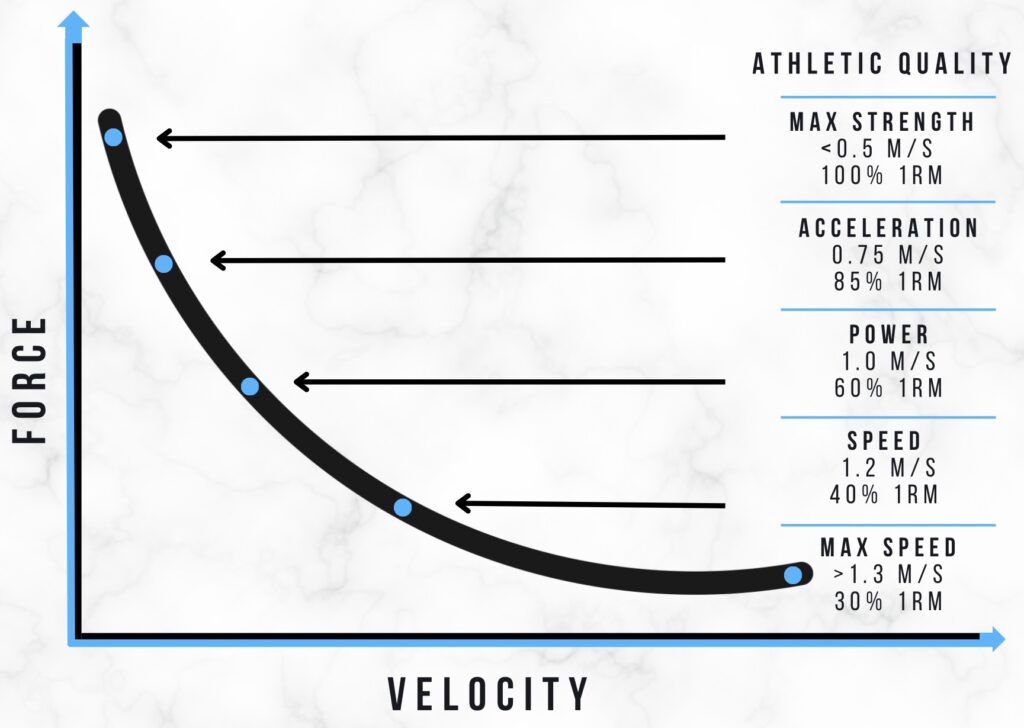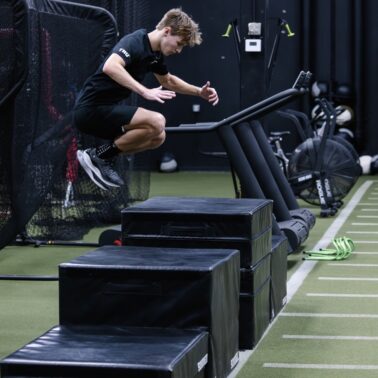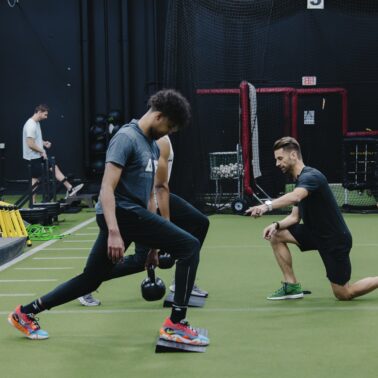“Velocity based training provides specific and concise goals that logically progresses any performance or rehabilitation program.”
Adam Loiacono
What You will Learn
- What is velocity based training (VBT)?
- Why is VBT a valuable tool?
- How to implement VBT within your own rehab or training program?
Introduction to Velocity Based Training
Velocity Based Training is a method that focuses on the speed of movement in weight training exercises. Unlike traditional strength training, which often emphasizes the amount of weight lifted, VBT prioritizes the velocity of the lift. The central idea is that the speed of the lift is a more relevant indicator of performance, especially in sports where power and speed are crucial.
The foundation of VBT lies in the force-velocity relationship, a key principle in exercise science. This relationship indicates that as the speed of a contraction increases, the force it can generate decreases, and vice versa. In practical terms, when an athlete lifts a heavier weight, they do so more slowly, and when they lift a lighter weight, they can move it more quickly.

(above image): The Force-Velocity curve is the keystone metric and reference for Velocity Based Training
Application in Sports Rehabilitation
In sports rehabilitation, VBT offers a unique advantage. It allows for the customization of training intensity based on the athlete’s current condition and the specific requirements of their sport. For instance, an athlete recovering from a knee injury might start with low-velocity, high-force exercises and gradually progress to high-velocity, low-force movements as their recovery advances.
VBT Equipment
Modern VBT utilizes technology like linear position transducers or accelerometers to measure the speed of the barbell or the athlete during exercises. This technology provides immediate feedback, allowing athletes and coaches to adjust the training intensity in real-time based on the velocity readings.
Self-Regulation
Velocity-based training (VBT) is self-regulating because it adjusts to an athlete’s daily performance capabilities. Unlike traditional training methods that rely on predetermined weights and reps, VBT uses real-time velocity data to guide intensity. Athletes perform exercises with a target velocity, which reflects their current strength and fatigue levels. If they can’t maintain the velocity, it indicates fatigue or reduced performance, prompting lighter weights or fewer reps. This approach ensures training stays within optimal intensity ranges, reducing injury risk and enhancing progress by adapting to the athlete’s day-to-day condition. VBT thus personalizes training, making it responsive and efficient.
Speeds and Specific Adaptations
Low-Velocity Training: Absolute & Accelerative Strength
Low-velocity, high-force training is typically employed in the early stages of rehabilitation or when the focus is on building maximal strength. This type of training is beneficial for repairing and strengthening muscles, tendons, and ligaments after an injury. It involves lifting heavier weights at a slower speed, which stimulates hypertrophy and foundational strength gains. The speed zone ranges from 0.30 – 0.75 m/s.
Moderate-Velocity Training: Strength-Speed & Speed-strength
Moderate-velocity training strikes a balance between strength and power development. It’s particularly useful for athletes in the intermediate stages of rehabilitation. This type of training helps in transitioning from strength-focused exercises to more dynamic movements, crucial for many sports. This phase is a great way to introduce speed without introducing impact. The speed zones ranges from 0.75 – 1.0 m/s.
High-Velocity Training: Starting Strength
High-velocity, low-force training is essential for the later stages of rehabilitation, especially for athletes in sports requiring quick, explosive movements. This training focuses on power development, improving the rate of force development, and neuromuscular efficiency. It involves lifting lighter weights at a rapid speed, mimicking the speed and power required in most sports activities. In order to achieve high speeds that approach 1.2 – 1.3 m/s typically that athlete will be performing plyometrics. The speed zones are typically greater than 1.0 m/s.
Science, Application, and Research
Numerous studies have demonstrated the efficacy of VBT in sports rehabilitation. These studies highlight how VBT protocols have successfully been implemented to accelerate recovery, enhance performance, and reduce the risk of re-injury.
- “Velocity-based training: From theory to application” by Weakley et al. (2020), which provides a comprehensive overview of the theoretical and practical applications of VBT in strength and conditioning.
- “The reliability of individualized load–velocity profiles” by Banyard et al. (2018), focusing on the reliability of VBT in determining individual training loads.
- “Lifting velocity as a predictor of the maximum number of repetitions” by Miras-Moreno et al. (2022), investigating the use of lifting velocity to predict exercise capacity in resistance training.
- “Velocity loss as an indicator of neuromuscular fatigue during resistance training” by Sánchez-Medina & González-Badillo (2011), exploring how velocity loss can signal fatigue in resistance training.
- “Superior changes in jump, sprint, and change-of-direction performance following 6 weeks of velocity-based training” by Banyard et al. (2020), comparing VBT with traditional training methods in terms of athletic performance enhancements
Conclusion
Velocity Based Training represents a significant advancement in the field of sports rehabilitation. By tailoring the training velocity to the specific needs and recovery stages of an athlete, VBT offers a more nuanced and effective approach to rehabilitation compared to traditional methods. As research continues to evolve, VBT is poised to become a cornerstone in sports medicine and athlete training programs.



